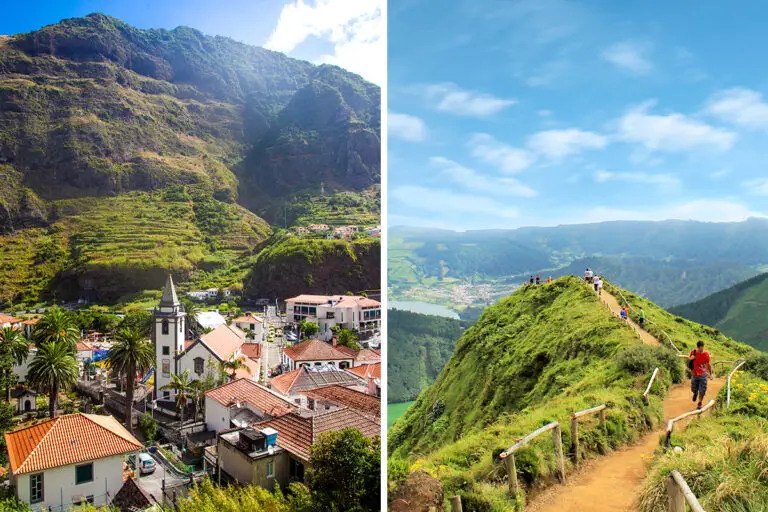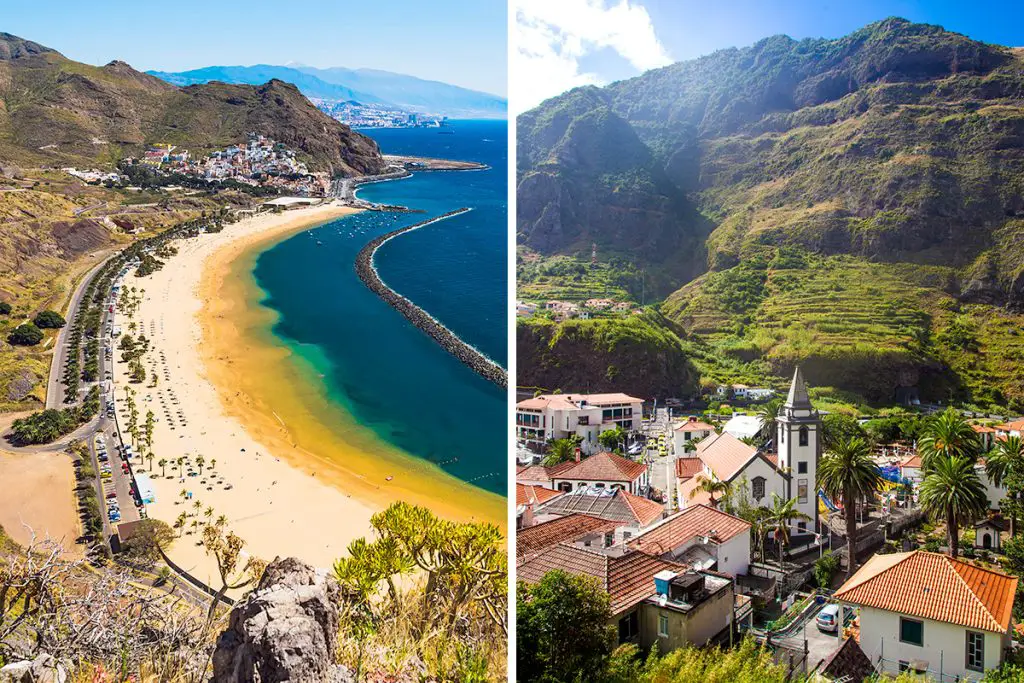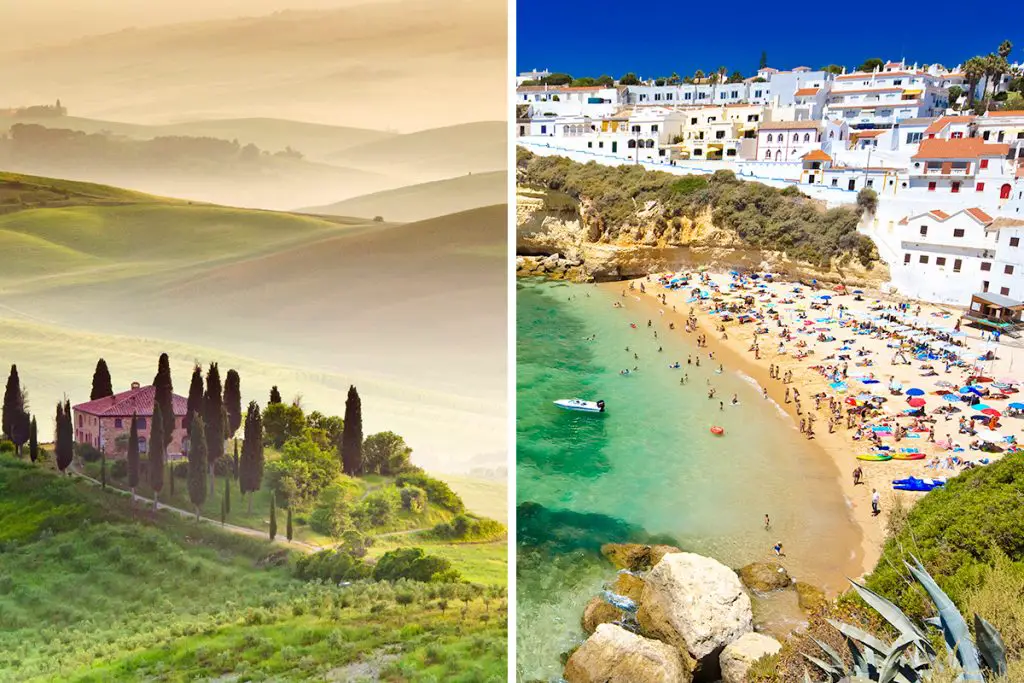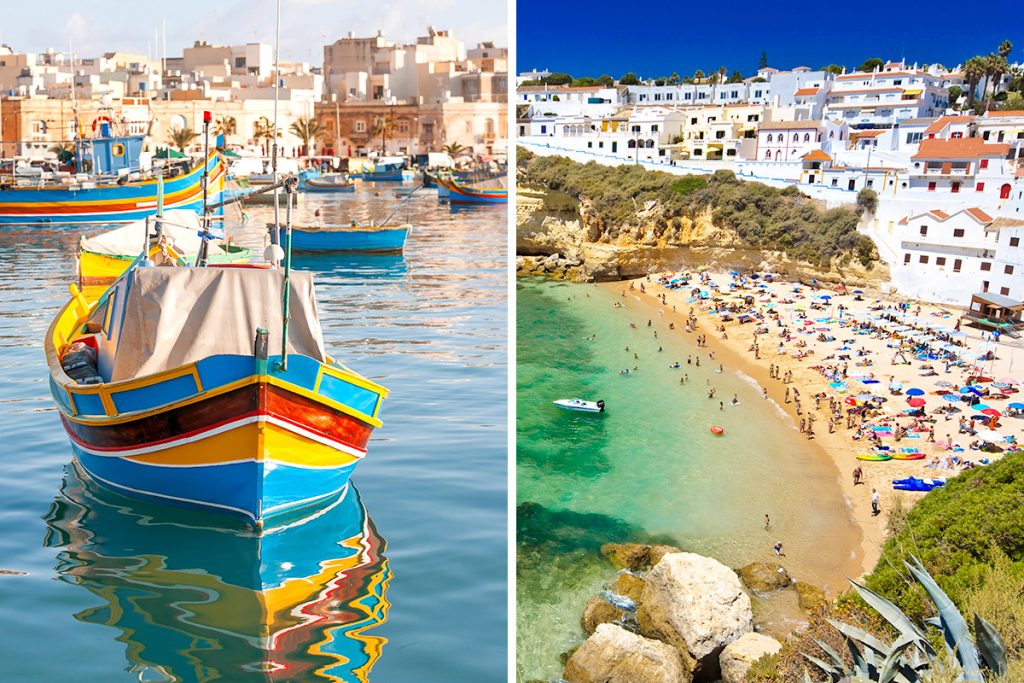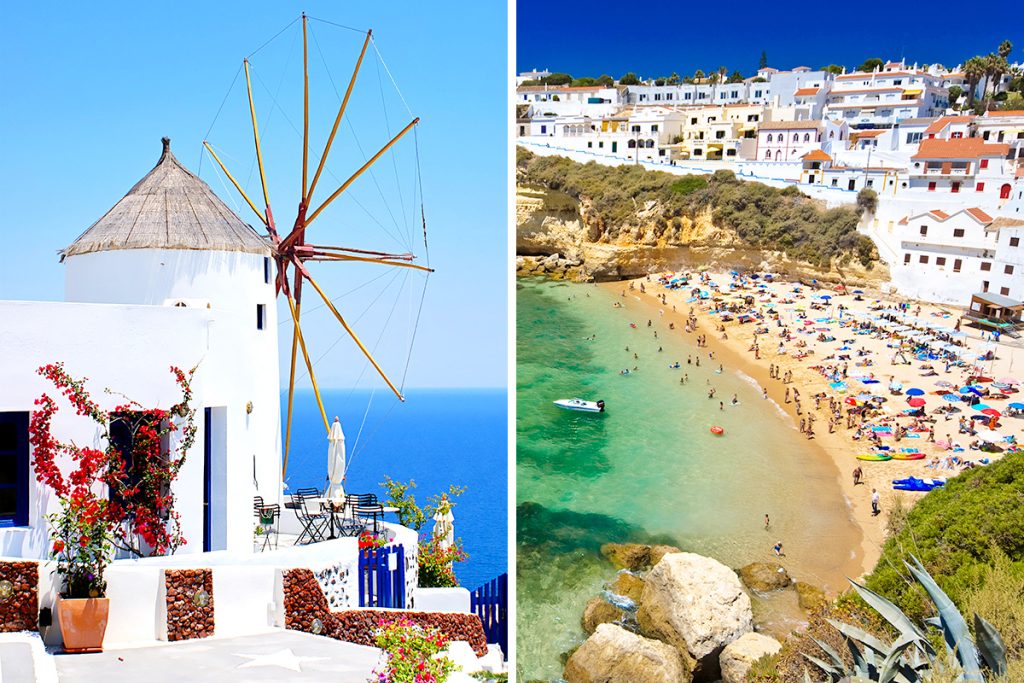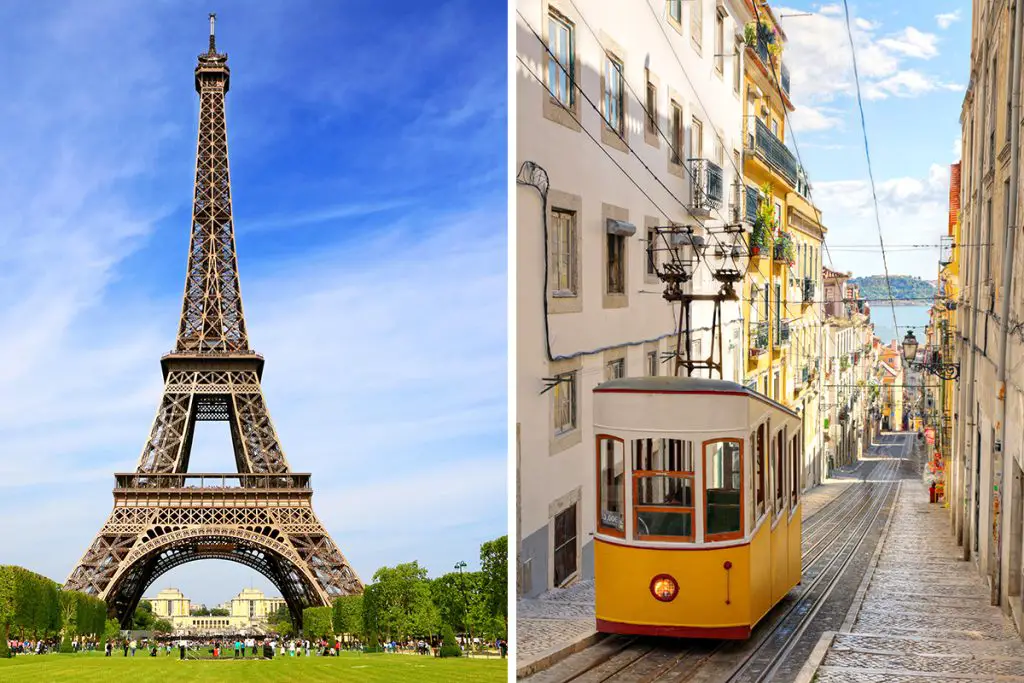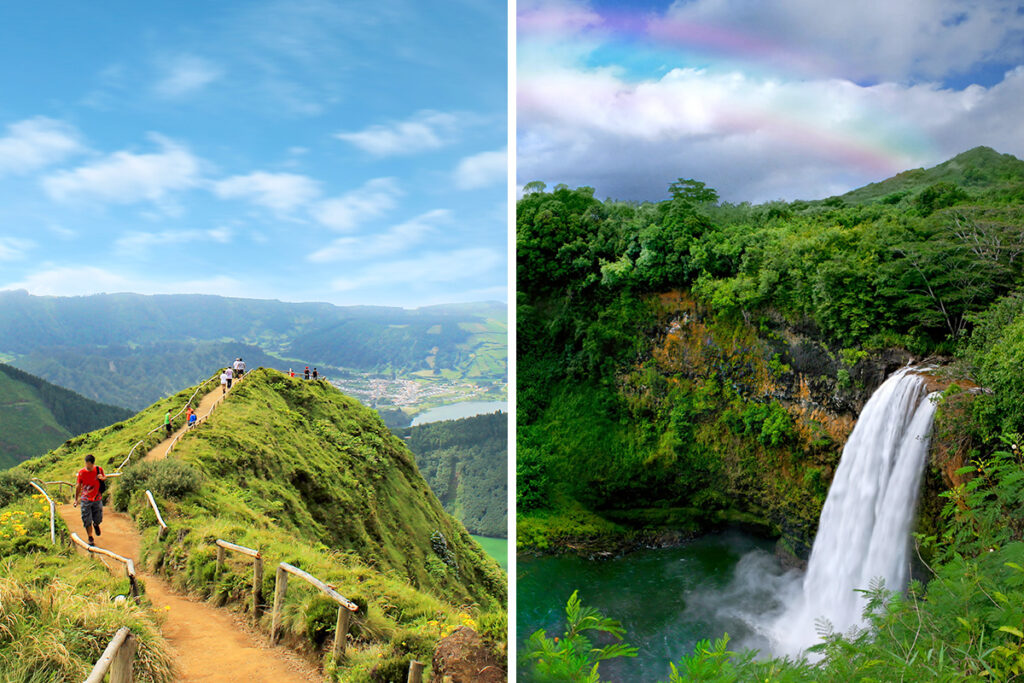Welcome, traveler, to a tale of two paradises, each with their own unique charm and allure. Will it be the enchanting gardens of Madeira or the breathtaking volcanic landscapes of the Azores that captivate your wanderlust? The choice is yours, but fear not, for we are here to guide you through this epic showdown. Read on, adventurer, as we reveal the hidden gems of Madeira and the Azores.
History & Culture
Let’s embark on a journey into the past, unraveling the rich tapestry of history and culture that adorns Madeira and the Azores. Both island groups boast a fascinating heritage, deeply rooted in the age of exploration and discovery.
Madeira’s history is one of strategic significance. Its location made it a vital stopover for Portuguese explorers as they charted new routes to Africa, Asia, and the Americas. The island’s vibrant culture is a blend of Portuguese, African, and even British influences, creating a unique mosaic of customs, art, and architecture.
The Azores, on the other hand, were born from volcanic activity, sculpting a landscape that exudes raw beauty. Early settlers in the 15th century hailed from Portugal, Flanders, and even Moorish territories, imbuing the islands with a rich and diverse cultural heritage.
Today, the Azores retain their distinct identity, evident in their folk music, religious festivals, and traditional crafts.
Both Madeira and the Azores offer an immersive experience into their respective pasts. While Madeira shines with its cosmopolitan heritage, the Azores captivate with their untamed spirit and rugged charm.
In the end, it all comes down to what resonates with your soul. Are you drawn to the allure of Madeira’s refined elegance, or do the windswept vistas of the Azores call to your adventurous heart? The choice is yours, and the islands are waiting.
Attractions & Activities
Whether you’re an intrepid explorer or a lover of leisurely pursuits, Madeira and the Azores are teeming with opportunities to indulge your passions. Let’s take a closer look at what each destination offers in terms of attractions and activities.
Madeira’s enchanting beauty is yours to discover. Hike the levadas, the island’s iconic network of irrigation channels, which crisscross the lush landscapes, revealing waterfalls, panoramic vistas, and hidden corners. For thrill-seekers, a wicker toboggan ride from Monte down to Funchal is a must, offering a unique and exhilarating experience.
Botanical enthusiasts can explore Madeira’s exotic flora at the Monte Palace Tropical Garden or the Funchal Botanical Garden. History buffs, meanwhile, can stroll the cobbled streets of Funchal’s Old Town, admiring the carefully restored buildings and browsing the local markets.
The Azores, a volcanic archipelago, is a playground for nature lovers. Their geothermal wonders include steaming fumaroles, hot springs, and bubbling mud pots. São Miguel’s Furnas Valley, with its enchanting Terra Nostra Garden, is a prime example of the islands’ geological splendor.
Adventure seekers will relish the chance to explore the Azores’ dramatic landscapes through hiking, canyoning, or mountain biking. The volcanic craters of Sete Cidades, Lagoa do Fogo, and Caldeira Velha are just a few of the awe-inspiring sites that await your exploration.
Whale watching is another unique experience in the Azores. With nearly a third of the world’s cetacean species frequenting the surrounding waters, the islands offer unparalleled opportunities for up-close encounters with these majestic creatures.
Ultimately, Madeira enchants with its diverse activities and picture-perfect landscapes, while the Azores beckon with their rugged beauty and untamed spirit. The question remains: which island paradise will ignite your sense of adventure and leave you craving more?
Beaches
Beach enthusiasts will find plenty to enjoy in both Madeira and the Azores. While these destinations may not have the typical sandy beaches you’d expect, their coastal allure is undeniable. Let’s explore what each location has to offer when it comes to sun, sea, and surf.
Madeira’s coastline is characterized by volcanic rock formations and pebbled beaches. Praia Formosa is a popular choice, with its four pebble and black-sand beaches stretching over 1.2 miles (2 kilometers). For a more intimate setting, consider visiting the charming fishing village of Câmara de Lobos, where you can relax at the small pebble beach.
Another Madeira highlight is the picturesque village of Ponta do Sol, which boasts a beautiful pebble beach sheltered by a sea wall. The crystal-clear waters of the natural pools in Porto Moniz are also worth a visit, offering a unique swimming experience surrounded by dramatic volcanic rock formations.
The Azores, on the other hand, has a mix of sandy and volcanic beaches. On the island of São Miguel, the black-sand beach of Praia de Santa Bárbara is a popular spot for surfers, while Praia do Populo offers golden sands and calmer waters. Faial’s Porto Pim Beach, with its fine white sand and crescent shape, is a stunning choice for a relaxing day by the sea.
Terceira’s Praia da Vitória boasts an expansive sandy beach and a lively promenade. Additionally, the Azores’ natural pools, such as Biscoitos on Terceira and Mosteiros on São Miguel, provide delightful alternatives to traditional beach experiences.
Ultimately, Madeira’s pebbled beaches and natural pools offer a refreshing change from the usual sandy shores, while the Azores present a more varied beach experience with an array of sand colors and coastal formations. Your preference for beach ambiance will guide your decision between these two Atlantic gems.
Eating, Drinking & Nightlife
Culinary experiences and vibrant nightlife play a significant role in choosing a travel destination. Madeira and the Azores both boast unique food scenes and lively evening entertainment, but each location has its own distinct flavor. Let’s dive into the gastronomic delights and nightlife options that these Portuguese islands have to offer.
Madeira is known for its diverse and delicious cuisine. The island’s rich culinary heritage includes dishes like espetada (beef skewers) and black scabbardfish with bananas. The local markets, such as Mercado dos Lavradores in Funchal, showcase an array of fresh produce, including exotic fruits and vegetables.
The Azores, on the other hand, are famous for their seafood and slow-cooked dishes. Fish lovers will delight in the Azorean grilled limpets or stewed octopus, while meat enthusiasts can savor the cozido das furnas, a unique dish cooked in volcanic steam. The Azores also have a thriving dairy industry, which is evident in the wide variety of local cheeses available.
When it comes to drinking, Madeira’s eponymous wine is a must-try. This fortified wine has a rich history and comes in various styles, ranging from dry to sweet. Additionally, the island’s bars and cafés serve delicious poncha, a traditional beverage made with sugar cane rum, honey, and lemon.
In the Azores, wine lovers will enjoy the distinct volcanic wines produced on the islands, such as those from Pico’s UNESCO-listed vineyards. The Azorean tea plantation, Gorreana, also offers a unique tasting experience with locally grown and processed teas.
Nightlife in Madeira revolves around the bustling city of Funchal, where you’ll find a mix of bars, clubs, and live music venues. The island’s annual events, like the Madeira Wine Festival and the New Year’s Eve fireworks, provide unforgettable experiences.
The Azores offer a more laid-back nightlife scene, with cozy bars, pubs, and occasional live music events. The island of São Miguel is home to the archipelago’s liveliest nightlife, particularly in the city of Ponta Delgada.
In conclusion, both Madeira and the Azores present enticing food, drink, and nightlife options. Madeira may be better suited for those seeking a more vibrant night scene, while the Azores cater to travelers looking for a more relaxed and intimate atmosphere.
Shopping
Shopping can be an essential part of any vacation, offering the chance to explore local markets, discover handmade crafts, and find unique souvenirs. Madeira and the Azores both provide interesting shopping opportunities that reflect their distinct cultures and traditions. Let’s see what each destination has in store for avid shoppers.
Madeira’s shopping scene is centered around its capital, Funchal. Here, you’ll find a mix of designer boutiques, artisan shops, and local markets. Funchal’s historic market, Mercado dos Lavradores, is a vibrant hub where you can purchase fresh produce, flowers, and traditional Madeiran handicrafts like wickerwork and embroidery.
The island also boasts several shopping centers, such as Forum Madeira and Madeira Shopping, which cater to those seeking international brands and a wider range of products. Madeira is particularly known for its exquisite embroidery and wine, making these items popular souvenirs for visitors.
In the Azores, shopping is more focused on local products and handicrafts. The islands are famous for their artisanal crafts, including ceramics, handwoven textiles, and intricate woodwork.
São Miguel, the largest island in the archipelago, offers the most diverse shopping options, with a blend of local shops and modern shopping centers like Parque Atlântico and Solmar Avenida Center.
Azorean souvenirs often showcase the islands’ natural beauty and rich history. Locally made ceramics, such as the pottery from Lagoa or the intricate designs of Louça da Vila, make for excellent keepsakes. Handwoven baskets and rugs, as well as Azorean cheeses, are also popular among tourists.
Overall, shopping in Madeira tends to be more varied, with a blend of local crafts and international brands. The Azores, on the other hand, focus on traditional handicrafts and local products. Choosing between the two destinations depends on your shopping preferences and the type of souvenirs you wish to bring home.
Accommodation
A comfortable place to stay can make all the difference when choosing a holiday destination. Madeira and the Azores both offer a range of accommodation options to suit different preferences and budgets. Let’s compare the lodging choices available in these two stunning locations.
In Madeira, you’ll find a wide variety of accommodation options, from luxury hotels and resorts to charming guesthouses and self-catering apartments.
Many of the upscale hotels are situated in Funchal, the island’s capital, providing easy access to shopping, dining, and attractions. Quintas, traditional Madeiran manor houses converted into boutique hotels, offer a unique and authentic lodging experience for those seeking a more intimate stay.
The Azores, on the other hand, have a more limited but growing selection of accommodations.
You can still find luxury hotels and charming guesthouses, especially on the larger islands like São Miguel and Terceira. Rural tourism is also gaining popularity in the Azores, with many travelers opting to stay in traditional cottages or eco-lodges that showcase the islands’ natural beauty and sustainable practices.
When it comes to choosing between Madeira and the Azores for accommodation, the decision largely depends on your personal preferences and priorities. Madeira offers a broader range of options, while the Azores provide a more authentic and nature-focused experience.
Family-Friendliness & Children’s Activities
When traveling with family, ensuring that there are suitable activities and an overall family-friendly atmosphere is essential. Both Madeira and the Azores have much to offer for families with children. Let’s delve into the family-friendliness and children’s activities that each destination provides.
Madeira is a popular family destination, offering a multitude of activities that cater to all ages. Children can enjoy the island’s many parks, gardens, and playgrounds, while parents relax and take in the stunning surroundings.
Family-friendly attractions such as the Madeira Theme Park and the Funchal Cable Car provide fun experiences for the whole family. In addition, the island’s gentle waters and sandy beaches make it an ideal spot for families to swim and unwind.
The Azores, being a more nature-oriented destination, offers a different kind of family experience. Families can explore the stunning volcanic landscapes, go whale watching, or visit one of the many picturesque lagoons for a day of swimming and picnicking.
The larger islands, like São Miguel and Terceira, have family-friendly attractions such as Terra Nostra Park and Algar do Carvão, which will engage children and adults alike. While the Azores may not have as many traditional children’s activities as Madeira, the islands’ natural beauty and outdoor adventures make for an unforgettable family vacation.
In conclusion, both Madeira and the Azores have their unique appeal when it comes to family-friendliness and children’s activities.
Madeira offers more traditional family attractions, while the Azores provide an opportunity to connect with nature and experience thrilling outdoor adventures. The choice between these two destinations ultimately depends on your family’s preferences and interests.
Getting There & Getting Around
Ease of travel and transportation options are essential factors to consider when planning a vacation. In this section, we will discuss how to get to Madeira and the Azores and the transportation options available at each destination once you’ve arrived.
Getting to Madeira is relatively straightforward, with most travelers opting to fly into Cristiano Ronaldo Madeira International Airport (FNC) in Funchal.
The airport is well-connected with direct flights from major European cities, and the flight duration from Lisbon is approximately 1 hour and 30 minutes. From the airport, it’s a short 13 miles (21 kilometers) drive to the city center of Funchal.
On the other hand, the Azores archipelago consists of nine islands, and travelers typically fly into João Paulo II Airport (PDL) in Ponta Delgada on São Miguel Island. There are direct flights from major European cities, as well as connections via Lisbon. From Lisbon, the flight takes around 2 hours and 30 minutes.
Once you’ve arrived in the Azores, you may need to take additional flights or ferries to visit other islands.
When it comes to getting around Madeira, renting a car is the most convenient option for exploring the island at your own pace. The island has a well-developed road network, making it easy to navigate. Public buses are also available, but they may not provide the same flexibility and convenience as a rental car.
In the Azores, car rental is similarly popular for exploring São Miguel and other larger islands like Terceira and Faial. However, for smaller islands, public transportation options, such as buses and taxis, may suffice. When traveling between the islands, ferries and domestic flights are the primary transportation modes.
Ultimately, both Madeira and the Azores have their unique transportation options and considerations. Madeira may be more accessible for those who prefer a single-island experience, while the Azores offer the excitement of island-hopping adventures.
Weather
When planning a trip, understanding the climate and weather conditions of your chosen destinations is crucial. In this section, we compare the weather of Madeira and the Azores to help you make an informed decision.
Madeira is known for its mild subtropical climate, making it a pleasant destination all year round. Summer temperatures range from 68°F to 77°F (20°C to 25°C), while winter temperatures are also quite mild, averaging between 59°F and 68°F (15°C to 20°C).
Due to the island’s mountainous terrain, microclimates can be found, with cooler temperatures at higher elevations.
The Azores, on the other hand, experience a maritime temperate climate, with mild temperatures throughout the year. In summer, the average temperatures range from 62°F to 75°F (17°C to 24°C), while winter temperatures are typically between 53°F and 62°F (12°C to 17°C).
The weather in the Azores can be more unpredictable, with frequent rain showers and occasional storms.
In conclusion, both Madeira and the Azores offer relatively mild and comfortable temperatures year-round. However, Madeira may be the preferred choice for those seeking more stable weather conditions, while the Azores cater to travelers who don’t mind a bit of unpredictability in their adventure.
Safety
Safety is a top priority when traveling, and understanding the security conditions of your chosen destinations can make your trip more enjoyable. In this section, we examine the safety aspects of both Madeira and the Azores.
Madeira is generally regarded as a safe destination for tourists, with low crime rates and a welcoming atmosphere. Petty crimes such as pickpocketing and bag-snatching are rare, but it’s still advisable to keep your belongings secure and maintain awareness of your surroundings.
Similarly, the Azores are considered safe for travelers, with low crime levels and a peaceful environment. Like Madeira, it’s essential to exercise common sense and take standard precautions to protect your valuables.
Natural hazards are another aspect to consider when evaluating the safety of a destination. Madeira’s mountainous terrain can pose risks for hikers, so it’s essential to be well-prepared and informed about trail conditions. In the Azores, volcanic activity and seismic events are possible, but the monitoring and alert systems in place help to mitigate any significant risks.
In conclusion, both Madeira and the Azores are relatively safe destinations for travelers. Practicing common sense and staying informed about local conditions will ensure a secure and enjoyable trip.
Cost
When planning a vacation, budget is an important consideration. In this section, we’ll compare the cost of visiting Madeira and the Azores to help you make an informed decision.
Madeira offers a range of accommodation, dining, and activity options, catering to various budgets. On average, a mid-range hotel in Madeira costs around €100 (approximately $120) per night. Dining out can also be affordable, with local restaurants offering meals for around €15 to €20 (approximately $18 to $24).
On the other hand, the Azores provide a more affordable travel experience overall. Mid-range hotels typically cost around €70 (approximately $84) per night, and meals at local restaurants can be found for €10 to €15 (approximately $12 to $18). This makes the Azores an attractive option for budget-conscious travelers.
In summary, while both Madeira and the Azores offer a variety of choices for different budgets, the Azores tend to be a more affordable destination. By carefully planning your trip and selecting suitable options, you can enjoy a memorable vacation without breaking the bank.
Which Is Better – Madeira or Azores?
Deciding between Madeira and the Azores can be challenging, as both islands offer unique experiences. Let’s summarize the key points from our comparison to help you make a choice.
When it comes to history and culture, Madeira shines with its vibrant traditions and rich past. However, the Azores have a more laid-back and authentic atmosphere, making them ideal for travelers seeking a more immersive experience.
In terms of attractions and activities, Madeira boasts an array of options, from scenic hikes to breathtaking viewpoints. The Azores offer diverse outdoor adventures, such as whale watching, diving, and exploring volcanic landscapes.
As for beaches, Madeira has rocky shores with stunning ocean views, while the Azores boast sandy beaches perfect for sunbathing and swimming.
Regarding eating, drinking, and nightlife, Madeira offers a more cosmopolitan experience with a variety of dining options and bustling nightlife. The Azores, on the other hand, present a more low-key experience focusing on local cuisine and traditional establishments.
Shopping in Madeira tends to be more diverse, with a mix of designer stores and local markets. The Azores offer a more modest shopping experience, focused on local products and souvenirs.
Accommodation options in both destinations cater to various budgets, with Madeira having a broader range of choices. The Azores, however, generally offer more affordable options.
Family-friendliness and children’s activities are abundant in both Madeira and the Azores, with each destination offering unique experiences for families to enjoy.
In terms of getting there and getting around, Madeira is easier to access, but the Azores have a more comprehensive public transportation system. Both destinations require some planning to navigate efficiently.
When comparing the weather, Madeira boasts a mild climate with consistently warm temperatures, while the Azores experience more varied weather conditions.
Safety is a priority for both destinations, with low crime rates and a focus on visitor well-being. Madeira and the Azores share similar safety concerns, such as weather-related incidents and natural hazards.
Finally, the Azores generally offer a more budget-friendly experience than Madeira, making them an attractive option for cost-conscious travelers.
In conclusion, choosing between Madeira and the Azores depends on your preferences and priorities. Madeira may be more suitable for those seeking a vibrant atmosphere, diverse attractions, and a mild climate. The Azores, on the other hand, may appeal to travelers looking for a more affordable and nature-focused getaway. Ultimately, both destinations offer unforgettable experiences and memories to cherish.

